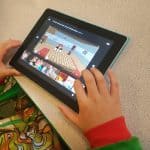Identity, Image and Reputation
1.1
The Citizenship strand is slightly different from the other three in that it focuses as much on information as it does on skills. There are also Online Safety year-by-year schemes of learning created by South West Grid for Learning on behalf of the Welsh Government which cover much of the Citizenship strand. This resource can be found on Hwb (link below)
We therefore restrict ourselves in the Citizenship strand to a few quick suggestions for activities, focusing on those few aspects of Citizenship not covered by the SWGfL schemes.
Activity Suggestions
Location and Metadata
Create a fake social media page (either an example page on a PowerPoint or a page such as Fakebook (classtools.net)). Make sure the most recent post is about visiting a public location e.g. the beach.
Discuss with pupils some benefits and negatives of publishing your locations:
- Your friends can find you, people know that you went somewhere cool or interesting,
- You can be located by people you may not want to see, you can't pretend to have been elsewhere
Show the amount of information held in a photo (time, date, location, camera). Use a metatag viewer website (just google "view photo metatag") to show pupils just how much detail is contained in one photo.
'Picture Perfect' (Lesson 5, Year 5 of the SWGfL Online Safety schemes of learning) deals with photoshop and it's effect on negative body image.
Personal Information, Device Access and Secure Sites
Show them an example of an app asking permission to access camera, photos or microphone on a phone or tablet. Explain that whilst we usually accept such requests in school (since the school apps have been chosen by a teacher), at home we should be more careful and think why an app would want such access.
Similarly, show them a website that asks for personal information before granting access (practically any website that you need to register for). Why does the website want such information? It might be so that it can personalise its content for you, but it could also be so that they can sell your info to marketing companies.
- Lesson 3, Year 6 of the SWGfL Online Safety schemes of learning deals with Privacy Rules
Online Presence
Regularly discuss the fact that people try to make themselves look good online, only posting positive things about themselves and never anything bad. Remind them that they should keep this in mind if they ever think that other people's lives are 'amazing'. Everyone has sad moments and everyone has happy moments.

